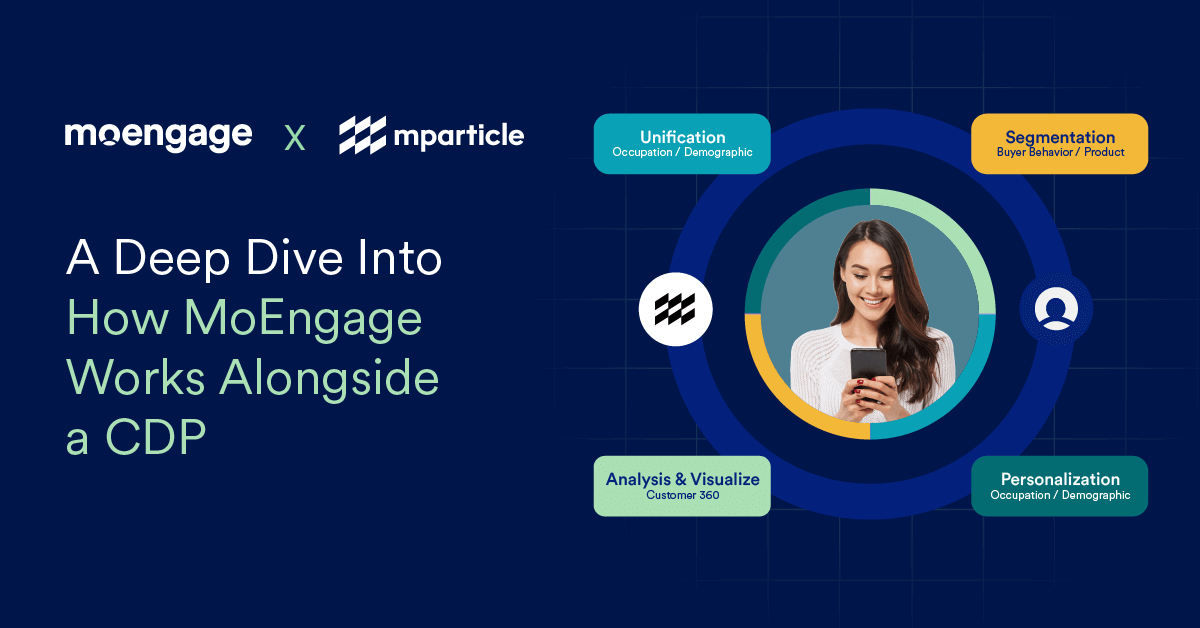A Deep Dive Into How MoEngage Works Alongside a CDP

Reading Time: 3 minutes
| Note – This article has been contributed by the team at mParticle with insights from Joey Colvin. |
Marketers worldwide have realized the benefits of a combined Customer Data Platform (CDP) + Customer Engagement Platform (CEP) solution. By leveraging these tools in tandem, brands can manage customer data from different data sources, perform customer analytics using machine learning, and ensure that connected data sources reap the benefits of the integration.
In this article, we’ll dive deep into how brands can make the most out of a CDP alongside MoEngage and the different steps involved.
How Does MoEngage Integrate with CDPs
MoEngage seamlessly integrates with the leading CDP providers, including mParticle. All of our native integrations with CDPs support bi-directional data flows, allowing brands to enrich customer data with campaign data and vice versa.
You can discover more CDP partners here.
How MoEngage Works Alongside a CDP
Below are the following steps you can take to unlock value from customer data and leverage it to drive better engagement, retention, loyalty, and lifetime value:
Step 1: Aggregate customer data from across channels
A CDP simplifies data infrastructure by collecting customer data from various sources and unifying it to a 360-degree customer view, supporting better analytics and customer engagement.
Step 2: Forward 360-degree customer profiles to MoEngage
CDP merges historical purchases and preference data with real-time behavioral data, creating unique, comprehensive customer profiles. These 360-degree customer profiles are forwarded to MoEngage in real time—no development work required.
Step 3: Build cohorts in MoEngage
Once that data has been forwarded to MoEngage, you can use it to create cohorts of customers based on the Recency, Frequency, and Monetary value of their transactions. Brands can further enrich the customer profiles with this information, identify customers with high purchase intent, and send them targeted communication.
For example, an omnichannel grocery chain can aggregate purchase data across POS, E-commerce, and Apps and pass it to MoEngage, where marketers can leverage the automated predictive segments from MoEngage to build effective campaign strategies. They can personalize offers based on the segment – for example, potential loyalist customers get offers based on the number of visits in a month, and champions get offers based on basket size.

How Can Your Brand Benefit From Data-Driven Personalization?
The bi-directional integration with CDPs helps brands to –
- Target the right customers: You can segment customers by behavior or preferences by leveraging customer data from a CDP platform. MoEngage creates predictive segments, affinity scores, and churn risks so that you can leverage this for targeted campaigns.
- Personalize experiences: You can use the interest and intent data from every customer touchpoint to send the right message at the right time and capture your customers’ micro-moments.
- Analyze customer behavior accurately: CDP will collect commerce attributes such as event counts and occurrences across different channels. MoEngage helps to uncover insights from this high-quality data set, such as consumer behavior, trends, user paths, and affinities.
Common Use-Cases for CDPs and CEPs
While there are many use cases you can accomplish using CDPs and CEPs, here are a few common ones –
- Personalizing outbound communication based on the real 360 view of the customer.
- Reaching customers on the most cost-effective channels while considering their reactiveness in each channel.
- Re-targeting shoppers via email or ads based on similar considerations.
- Re-engaging lapsing customers or subscribers with a multi-channel campaign.
- Improving media spending effectiveness by excluding existing customers from acquisition campaigns.
Summarizing this, CDPs provide a real-time customer data foundation, including campaigns a customer reacted to, recent browsing and purchase history (with details like average margin or returns quota), and complex attributes that are important for the specific business model of a brand.
CEPs provide the activation layer on top of that for the channels that a brand owns. By using both together, marketers can build more intelligent campaigns more quickly, be way more granular in their targeting, and orchestrate owned channels with their performance marketing.
Wrapping it Up
As we navigate the ever-evolving world of customer data, leveraging a customer engagement stack that includes a CDP and a CEP is not just a choice but a necessity for businesses aiming to thrive in the digital era.
Further Reading |







